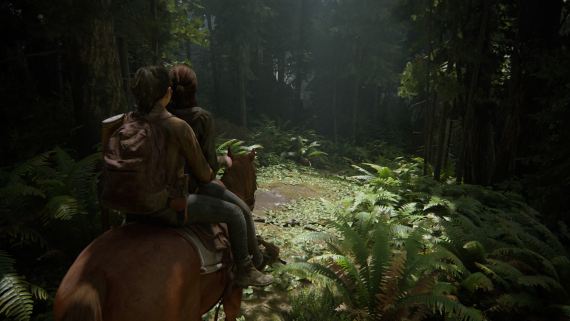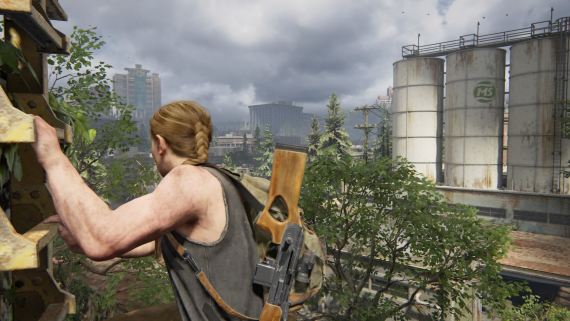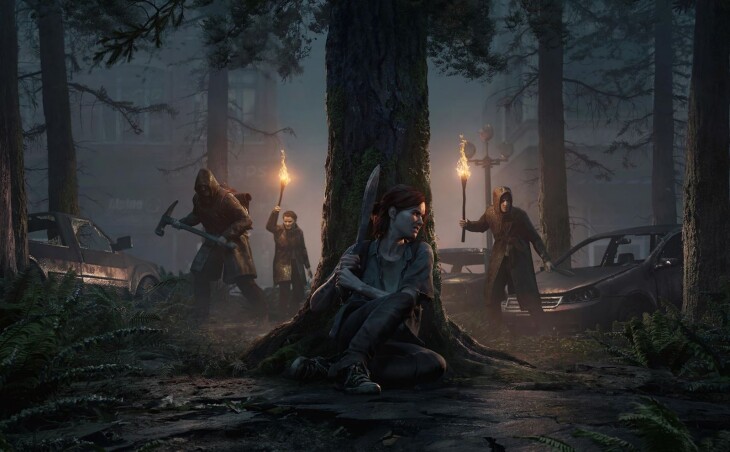It cannot be denied that The Last of Us is one of the top games for Sony consoles. An amazingly presented post-apocalyptic world, an ingenious implementation of the zombie epidemic theme, and above all a great story based on the developing relationship of the protagonists.
A new point of view
In the first part of the game, we mainly played Joel, while Ellie was most of the time an escorted enpoche who sometimes saved his guardian by stabbing a knife into the attacker or with an additional first aid kit. It was only at a later stage (and in the Left Behind expansion ) that we had the opportunity to play the heroine, and only for a moment.
Attention! Spoilers may appear later in the text, albeit within reason.
In The Last of Us. We play Part 2 as the protagonist of the first part only at the very beginning. For 99% of the game we control Ellie or a completely new character – Abby. It’s a bold move that made quite a lot of sense. Our heroine is mature, she is grown up and new people have appeared in her life. The events in Salt Lake City and the decision made by Joel left a mark on his relationship with the student. We got to know its history, motives and point of view. The creators decided to introduce us to the perspective of others.

Of course, you may not like this solution. Many people counted on the next adventures of the duo from the first part. In my opinion, the writers’ idea from Naughty Dog is more interesting. Focusing on Ellie and new characters gives you the opportunity to deepen their characters and build relationships with each other. It also gives a slightly different dynamics to the game, because at different stages of the game we are accompanied by other people with whom we work in different ways. The more so because the authors took care of a really large variety of threads. So we have an account of Ellie and Dina and her ex-boyfriend Jesse, the story of Abby and her friends, and siblings who escaped from a group of religious fanatics. And in the background there are flashbacks about Joel.
The arrhythmia of the narrative
However, I am not entirely positive about the structure of the story and its pace. At the very beginning of the game, we take turns controlling Joel, Abby and Ellie. After the dramatic events of the prologue, we play the role of Ellie again, who, together with her girlfriend Dina, sets out in a chase. And we play it until the climax and the clash, after which we… jump to a flashback from Abby’s life.
I understand that the authors of TLoU 2 wanted to introduce us to the history of antagonists, develop them better, show their motives and make them a more ambiguous opponent. However, it would be a better idea to gradually introduce them and contrast them with the main characters towards the end of the story. Putting on cliffhanger w połowie fabuły, żeby cofnąć się w czasie i przedstawić nam nowe postacie nie do końca się sprawdza, bo o ile można kibicować Abby, wczuć się w sytuacje jej i jej towarzyszy, to trudno nie być po stronie postaci, którym poświęcono pierwszą połowę gry, całą poprzednią część, dodatek oraz komiks. Zamierzona paralela jest zaburzona przez brak równowagi. W trakcie rozgrywki ma się wrażenie, że ktoś połączył w całość dwie odrębne historie i niestety szwy są aż nadto widoczne, gdy bohaterowie zachowują się nieracjonalnie lub niezgodnie ze swoim charakterem tylko dlatego, że wymaga tego od nich scenariusz. Niezbyt satysfakcjonujące, delikatnie rzecz ujmując, jest również zamknięcie. Pierwsza część kończyła się w naprawdę piękny, wzruszający sposób. Epilog sequela w porównaniu do reszty historii sprawia wrażenie niedopracowanego szkicu.
Koniec spoilerów

Piękna, ale niezbyt inteligentna
Żadnych zarzutów nie mam do warstwy graficznej gry, która jest wprost zachwycająca. Śnieżyca na samym początku, zarośnięte trawą i mchem ruiny Seattle, rwące potoki, wzburzone morze, ogień trawiący budynki, sposób poruszania się postaci oraz animacje podczas modyfikacji broni – wszystko to prezentuje się przepięknie, a przypuszczam, że w 4K na wersji Pro wygląda jeszcze lepiej. Twórcy zadbali nawet o takie drobiazgi, jak powiększająca się kałuża krwi przy zabitym przeciwniku oraz trwałe ślady pozostawiane na podłodze po wdepnięciu w nią. Na pochwałę zasługuje również różnorodność modeli. Projektanci postarali się, żeby bohaterowie mieli urozmaicony wygląd odzwierciedlający ich styl życia i historię. Najbardziej widać to po atletycznej sylwetce i zaciętej minie Abby. Obsada głosowa również sprawdziła się pierwszorzędnie, a udźwiękowienie kapitalnie buduje atmosferę.
W kwestii mechaniki nie dokonano żadnej rewolucji. Podobnie jak w pierwszej części, dostępne umiejętności oraz arsenał różnią się nieco w zależności od postaci. Rozbudowano trochę drzewko rozwoju oraz dodano możliwość uniku i kontry podczas walki. Poprawiono również sposób likwidacji wrogów z zaskoczenia. W The Last of Us wybranie opcji „duszenie” nieraz skutkowało atakiem rodem z Mortal Kombat, na przykład zmiażdżeniem głowy oponenta butem. W Part 2 „ciche zabójstwo” to zwykle skręcenie karku lub wbicie noża w szyję.
Artificial intelligence in TLoU 2 may not be tragic, but it also does not knock you down – both for our opponents and allies. However, it still happens that our enemies do not notice us even when we kill in front of us, and our comrades sometimes disturb us more than help us. Several times I also managed to penetrate the textures of objects and fall outside the boundaries of the location (one time with a fatal result). However, I think the patch to fix these shortcomings is just a matter of time.

Find them all
Finally, it is also worth mentioning the very nice collectibles, easter eggs and bonus materials. The authors of Part 2 gave us the possibility of a rudimentary exploration, during which we can, for example, practice playing the guitar. From time to time, there is an option to continue the conversation, thanks to which we learn more about the heroes. As in the first part, we can look for two main types of hidden bullshit. The comic books were replaced by collector’s cards with superheroes, and the dog tags – by coins. There are a lot of them, so the set players will definitely have something to do in the New Game + mode. In addition, we receive points for progress in the game, thanks to which we can later unlock concept art and models in the gallery.

Not great, not terrible
Is The Last of Us 2 a good game? Definitely. Is it a flawless masterpiece? Certainly not. Is it a worthy continuation of the first part? I think so, although some of the fictional solutions do not convince me, and may even irritate other recipients. Is it good that it was created? In my opinion, yes. After all, even fatal sequels, remakes or adaptations do not destroy the original work. A The Last of Us. Part 2 is definitely far from being fatal.


